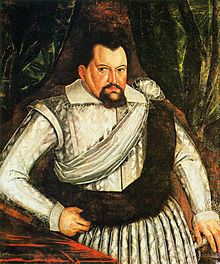Reign 1608–1619 Predecessor Albert Frederick | Successor George William Name John Elector Reign 1618–1619 Role Prince | |
 | ||
Spouse Duchess Anna of Prussia (m. 1594) Children George William, Elector of Brandenburg Parents Joachim III Frederick, Elector of Brandenburg, Catherine of Brandenburg-Kustrin Grandchildren Christina, Queen of Sweden Similar People George William - Elector of, John George - Elector of, Frederick William - Elector of, Maria Eleonora of Brandenburg, Catherine of Brandenburg | ||
John Sigismund, Elector of Brandenburg
John Sigismund (German: Johann Sigismund; 8 November 1572 – 23 December 1619) was a Prince-elector of the Margraviate of Brandenburg from the House of Hohenzollern. He became the Duke of Prussia through his marriage to Duchess Anna, the eldest daughter of Duke Albert Frederick of Prussia who died without sons. Their marriage resulted in the creation of Brandenburg-Prussia.
Contents
- John Sigismund Elector of Brandenburg
- Elector of Brandenburg and Duke of Prussia
- Religious policy
- Family and children
- References
Elector of Brandenburg and Duke of Prussia
John Sigismund was born in Halle an der Saale to Joachim III Frederick, Elector of Brandenburg, and his first wife Catherine of Brandenburg-Küstrin. He succeeded his father as Margrave of Brandenburg in 1608. In 1611, John Sigismund traveled from Königsberg to Warsaw, where on 16 November 1611 he gave feudal homage to Sigismund III Vasa, King of Poland (the Duchy of Prussia was a Polish fief at the time). He officially became Duke of Prussia in 1618, although he had served as regent on behalf of the mentally-disturbed Albert Frederick, Duke of Prussia, for several years prior. John Sigismund died in the following year.
John Sigismund gave the Reichshof Castrop to his teacher and educator Carl Friedrich von Bordelius, whereas he received the territories of Cleves, Mark, and Ravensberg in the Treaty of Xanten in 1614.
Religious policy
John Sigismund's most significant action was his conversion from Lutheranism to Calvinism, after he had earlier equalized the rights of Catholics and Protestants in the Duchy of Prussia under pressure from the King of Poland. He was probably won over to Calvinism during a visit to Heidelberg in 1606, but it was not until 1613 that he publicly took communion according to the Calvinist rite. The vast majority of his subjects in Brandenburg, including his wife Anna of Prussia, remained deeply Lutheran, however. After the Elector and his Calvinist court officials drew up plans for mass conversion of the population to the new faith in February 1614, as provided for by the rule of Cuius regio, eius religio within the Holy Roman Empire, there were serious protests, with his wife backing the Lutherans. Resistance was so strong that in 1615, John Sigismund backed down and relinquished all attempts at forcible conversion. Instead, he allowed his subjects to be either Lutheran or Calvinist according to the dictates of their own consciences. Henceforward, Brandenburg-Prussia would be a bi-confessional state.
Family and children
On 30 October 1594, John Sigismund married Anna of Prussia, daughter of Albert Frederick, Duke of Prussia (1553–1618). They were parents to eight children:
